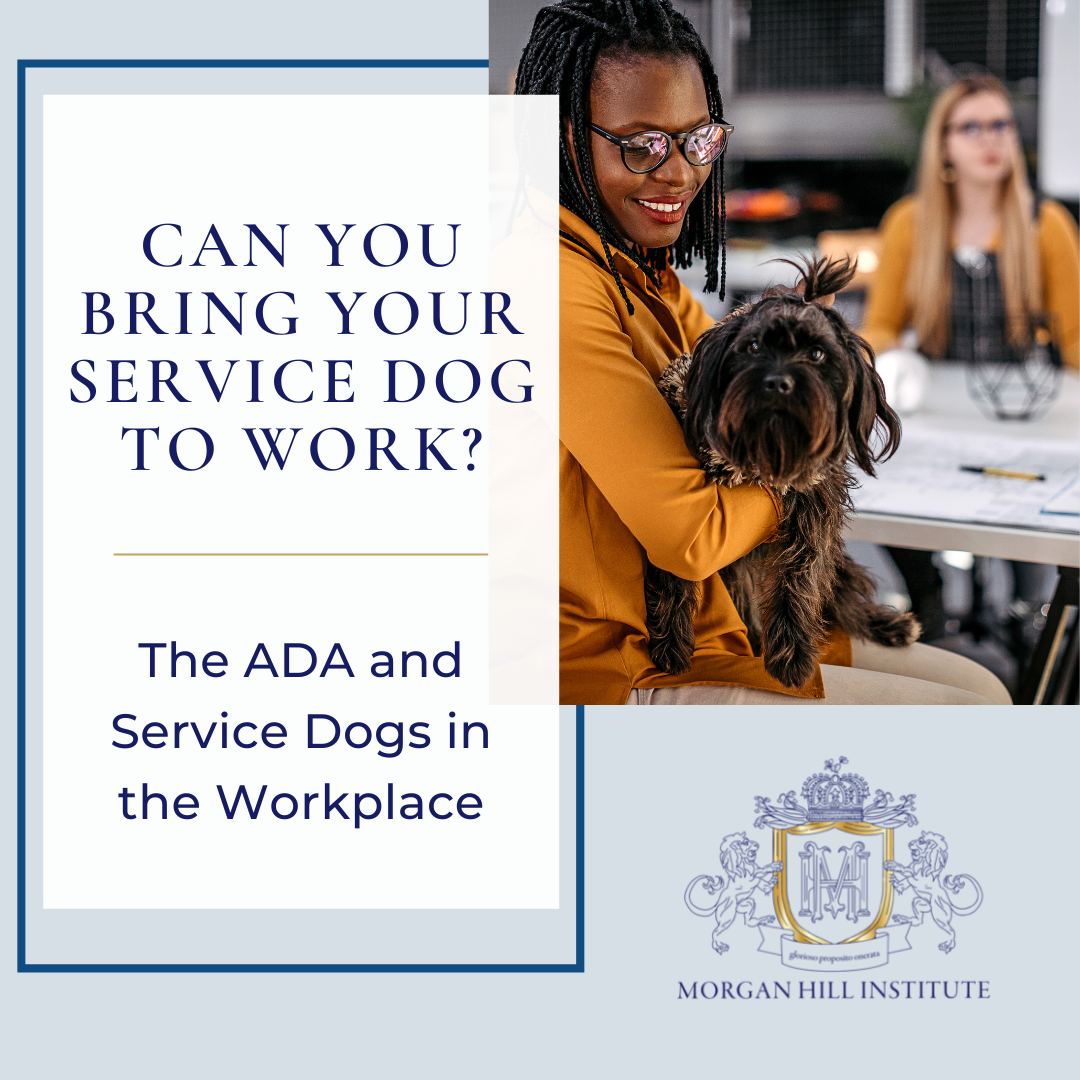The ADA and Service Dogs In The WorkPlace: Can You Bring Your Service Dog To Work?
Title I of the Americans with Disabilities Act prevents workplace discrimination. It makes it illegal to ask an applicant about disability status and provides for employees to request reasonable accommodations. This section addresses service dogs as a workplace accommodation. Other workplace accommodations are briefly described at the end of this section.
When an employer receives a request from an employee to bring a service dog to work it must be reviewed and considered like any other request for a reasonable accommodation under the Americans with Disabilities Act (ADA). Accommodations are considered reasonable when they do not create an undue hardship or create a direct threat. Each case must be considered individually. The ADA defines undue hardship as “an action that requires significant difficulty or expense in relation to the size of the employer, the resources available, and the nature of the operation.” Direct threat is defined as a “significant risk of substantial harm to the health or safety of the individual or others that cannot be eliminated or reduced by reasonable accommodation.”
Evaluating the Request for a Reasonable Accommodation
The request by an employee to use a service dog in the workplace as a reasonable accommodation should be processed in the same manner as any other request for a reasonable accommodation.
According to the Society for Human Resource Management (SHRM), the following steps should occur:
Determine if the employee is covered by the ADA. An employer with 15 or more employees must following the ADA, including state and local government offices. Federal employees are covered by the Rehabilitation Act of 1973 instead of the ADA, but the coverage provided is very similar.
Review policy and procedure for handling accommodation requests. This involves reviewing job descriptions and confirming they reflect current essential functions.
Verify that the employee is “qualified” for the position. An employee is considered qualified for a position if he/she has the requisite skills, experience, education, and other job-related requirements for the position, with or without reasonable accommodations, and can perform the essential functions of the position.
Start the Interactive Process. This is a good faith effort by both the employer and the employee to discuss the limitations or performance issues the employee’s disability may be creating. Information should be gathered from the employee, healthcare provider(s), and the employer.
Assess if the employee has a disability under the ADA. A disability is one of the following:
A physical or mental impairment that substantially limits a major life activity;
A record of a physical or mental impairment that substantially limits a major life activity;
Being regarded as having such an impairment
The following are NOT considered disabilities under the ADA:
Transvestism
Transsexualism
Pedophilia
Exhibitionism
Voyeurism
Gender identity disorders not resulting from physical impairments
Other sexual behavior disorders
Compulsive gambling
Kleptomania
Pyromania
Psychoactive substance use disorders resulting from current illegal use of drugs
The following conditions are automatically considered disabilities: deafness, blindness, intellectual disability, completely or partially missing limbs, mobility impairments that require the use of a wheelchair, autism, cancer, cerebral palsy, diabetes, epilepsy, HIV or AIDS, multiple sclerosis, muscular dystrophy, major depression, bipolar disorder, post-traumatic stress disorder, obsessive-compulsive disorder, and schizophrenia.
Major life activities include caring for oneself, performing manual tasks, seeing, hearing, eating, sleeping, walking, standing, lifting bending, speaking, breathing, learning, reading, concentrating, thinking, communicating, and working. Major bodily functions include the functions of the immune system, normal cell growth, digestion, bowel/bladder function, brain/neurological functions, breathing, blood circulation, and reproductive functions.
Determine Accommodations. An accommodation can be a change or modification in the workplace that allows the employee with a disability to perform the essential job duties or enjoy the benefits and privileges of employment. This can include job restructuring, reassignment or transfer to a vacant position, making existing facilities more accessible, modifying the work schedule, changing equipment or devices, adjusting training materials, or using interpreters for individuals with hearing or visual impairments. See end of section for additional information about reasonable accommodations.
Determine if the accommodation is “reasonable” or creates an “undue hardship.” Considerations for making these determinations include evaluating the cost of the accommodation and the financial stability of the company and/or modifications that would be sufficiently disruptive to alter the nature or operation of the job/business.
Notify the employee in writing. The employee must be provided with written notification that the requested accommodation has been approved or denied. For those that are approved, the anticipated start date should be included.
Review and modify the request. The suitability of the accommodations should be reviewed and/or modified as needed as the employment situation changes or the disability condition changes.
Specific Considerations for a Service Animal as a Reasonable Accommodation
Employers are not required to allow an employee to bring a service animal to work. The individual case must be evaluated to determine what is appropriate. If the employer allows other employees to bring animals to work, then they should allow a service animal as well. If the business has a no animals in the workplace policy, it should be evaluated to determine if the presence of a service dog would be an undue hardship for the business or present a safety issue for other employees or the public.
The employee must provide documentation of the disability and functional impairments from a healthcare provider. However, the healthcare provider may not have been involved with obtaining a service dog so he/she may not be able to verify information about the animal. In this case, information from the person who trained the dog should be considered. The employer’s expectation is that the service dog is appropriately trained and will not disrupt others in the workplace. A trial period may be used to determine if the service dog will be a workplace disruption.
There is no certification program for service animals that is recognized under the ADA. Therefore, employers cannot request a certificate as verification that the dog is a service animal. If there is reasonable cause to suspect an issue with the dog’s health the employer may request verification of general health and status of vaccines.
If the employee only needs the service animal while traveling to and from work and does not need it during the workday, the employer may provide a safe place for the dog to be during the workday. A safe space can also be provided if there are specific work areas that the dog cannot safely be in or if the employee has essential duties that the dog would be unsafe if exposed to.
Notifying Other Employees About a Service Dog
Employees should be notified in advance of a service dog’s initial arrival at the worksite. Employees may need to be educated about how a service dog differs from a companion or emotional support animal. If other employees express having an allergy or a dog phobia, the employer should work with them to minimize exposure to the service dog. This could include air purifiers, breathing masks, attending meetings virtually, or work from home options.
Communication with the employee who will be using the service dog is also essential. It should be determined if the employee would like to education peers about the service dog or provide a brief orientation/training. The most basic communication should consist of a notification to employees to let them know a service dog will be in the workplace and that they should not interact with it.
Service Dogs-in-Training
The training of service dogs begins in puppyhood with basic obedience and socialization. This phase is sometimes handled by volunteers who train the puppy for the first year and then return it to a parent organization to be matched to an individual with a disability and provided specific training for that handler.
If an employee requests to bring a service dog-in-training into the workplace, the employer is not required to approve it. The ADA does not establish an obligation for employees to allow an employee without a disability to bring a service dog-in-training into the workplace. The employer may approve the request if desired.
Emotional Support Animals in the Workplace
The ADA does not address having an emotional support animal in the workplace. There is no regulation that addresses if an emotional support animal qualifies as a workplace accommodation. The Department of Justice (DOJ) has determined that if the mere presence of a dog provides comfort (such as during an anxiety attack), it does not meet the standards established by the ADA. If the dog is trained to sense an anxiety attack is about to happen and to take a specific action to lessen the impact or even avoid it, then the dog does qualify as a service animal under the ADA.
If an employer is presented with a request for use of an emotional support animal, it should be considered under the same process as a request for a service animal. Medical documentation establishing the need for an emotional support animal can be requested. A trial period of having the emotional support animal in the workplace can be established and conducted before a final decision is made.
Additional Reasonable Workplace Accommodations
There are multiple ways to provide reasonable accommodations to an employee, often with minimal cost to the employer. Some common categories of workplace accommodations include job restructuring, accessibility, schedule changes, and support services.
Job restructuring involves an employer modifying a job by removing one or more job responsibilities. Job tasks are typically classified as either an essential function or a marginal function. A qualified individual must perform, with or without an accommodation, the essential functions of a position to be considered minimally qualified. Employers are cannot be required to remove an essential function as a reasonable accommodation. A marginal function is commonly associated with a job, but not very important. It could be identified in the job description as something the person “may” need to do, but not “must” do. Marginal functions can be removed as a reasonable accommodation.
Accessibility under the ADA is intended to provide a qualified applicant the ability to participate in the application process, to enable a qualified individual to perform the essential job functions, and to enable an employee with a disability to enjoy benefits and privileges available to other employees.
Schedule changes are another possible reasonable accommodation. It includes allowing an employee with a documented need to (1) reduce work to part-time, (2) adjust starting or ending times, or (3) changing the timing or duration of breaks.
Summary
The request by an employee to bring a service dog into the workplace should be handled like any other reasonable workplace accommodation. Service dogs do come with some unique requirements, but will not be a workplace disruption and like other reasonable accommodations, allow the employee with a disability to complete their job requirements.
disability rights and service dog expert melissa kaekel
Morgan Hill Institute’s Melissa Kaekel is an expert on disability rights in the workplace and service dogs. Interested in having Melissa consult for your organization or speak to your group, be a guest on your podcast, or be an expert source for a press piece? Learn more about consulting and speaking services here.







